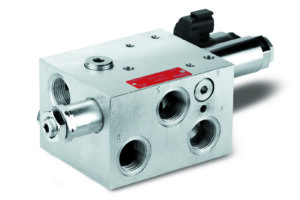 Over the years, driving speeds of construction vehicles have steadily risen. Even the small- and medium-sized machines for material handling and transport (wheel loaders and telescopic loaders) have followed this trend. Today, operators reach speeds of over 30 km/hr when driving on roads.
Over the years, driving speeds of construction vehicles have steadily risen. Even the small- and medium-sized machines for material handling and transport (wheel loaders and telescopic loaders) have followed this trend. Today, operators reach speeds of over 30 km/hr when driving on roads.
If a wheel loader drives over a bump, the resulting shock is transferred from the tire to the chassis, setting the mass of the boom in motion. This results in dangerous oscillation that can also compromise the safety and handling performance of the machine. In addition, transport goods may be hurled out of the bucket. Due to the constructional design and the weight sharing of a wheel loader, damping should ideally take place at the cylinders between the boom and the base vehicle to reduce the effect of the introduced pulse so that the resulting pitching motion of the vehicle remains in the controllable area of the driver.
Spatially optimized systems
For unsprung mobile working machines, the design team at ARGO-HYTOS created vibration damping systems in different designs and feature combinations. All they have in common is the fact that the movement of the bucket or boom is decoupled from the vehicle through hydraulic accumulators. Pipe rupture protection and constant accumulator pre-charging can be integrated just as accumulator safety valves and drain valves. The individual functional modules can be combined to a specific control block that can be integrated into existing hydraulic systems. The installation can be designed both for series production as well as for retrofitting. In most cases, no changes are needed with the existing hydraulic circuits. From the simple adding of accumulators over systems with adaptive accumulator pre-charging, up to fully integrated systems with pipe rupture protection, anti-cavitation, load-dependent damping and accumulator charging can all be designed.
Uncomplicated conversion or retrofitting
As the control block contains all necessary functions, mobile machines can be upgraded or retrofitted. There is no need to readjust the transport position of the bucket or the boom. The manifold does not create additional internal leaks. All that is needed to activate the damping is an electrical signal, generated depending on the speed or the operator. Additionally, because there is less wear on the machine material, the vibration damping systems also contribute to the longevity of the machine and thus help minimize total cost of ownership.
Argo-Hytos
argo-hytos.com
Filed Under: Mobile Hydraulic Tips